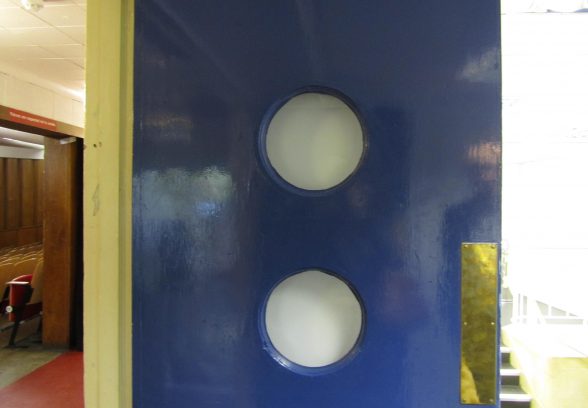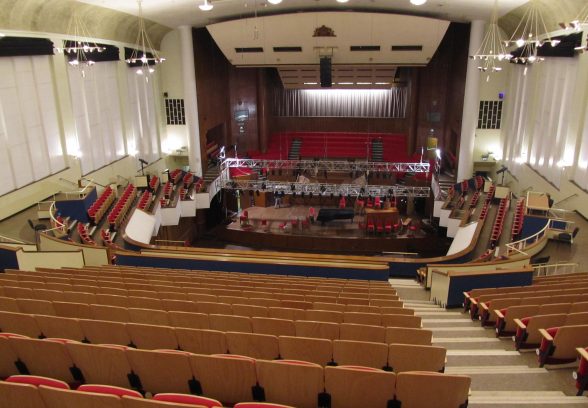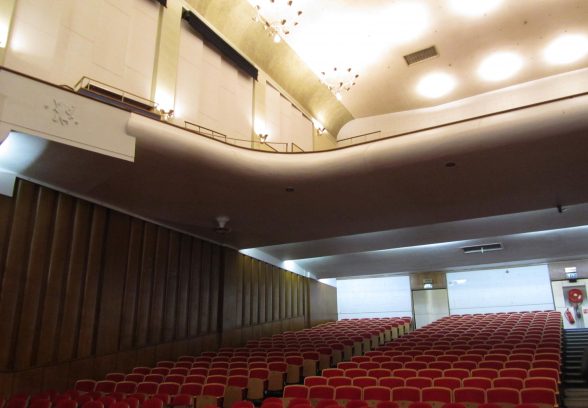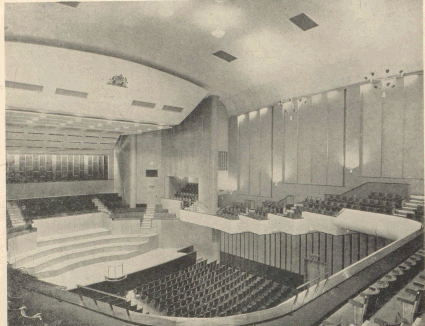This website uses cookies
This website uses cookies to enable it to function properly and to analyse how the website is used. Please click 'Close' to accept and continue using the website.






April 2017 - Colston Hall, Bristol
by Susannah Charlton
Colston Hall was one of the Festival of Britain concert halls, along with those on the South Bank, in Coventry and Manchester. It was part of Bristol’s contribution to the Festival and of the regeneration of Bristol after the war. The current Colston Hall auditorium is the fourth on the site, after fire destroyed previous incarnations. The most recent fire, started by a cigarette in 1945, gutted the building. So, while the exterior dates from the turn of the century, the interior was entirely rebuilt in Festival style in 1950-1 by Bristol city architect J Nelson Meredith – and very fine it was too. When it opened in 1951, the same year as the Festival Hall, Meredith’s interior, devised in partnership with the eminent acoustician Hope Bagenal, was considered one of the best of the Festival of Britain era in both acoustic and design terms.
The hall was built to seat an audience of 2,000 and a choir of 182, within the shell of the Victorian building. Despite those constraints, it is a well-proportioned space and has good acoustic standards. The fittings and furnishings were simple but of fine quality. The side walls are panelled in chestnut veneer detailed with strips of Mansonia (a hard wood from West Africa) and a Mansonia dado. The front of the auditorium has hardwood flooring of Muhuhu (from East Africa), so it could be used for dancing or exhibitions. It is remarkable that such exotic woods, imported from around the British Empire, were used at a time of post-war austerity when materials were scarce and expensive.
The previous 1936 design by C F W Dening included a deep balcony so that the hall could be used as a cinema. This was reinstated and is decorated with plaster motifs by Ernest Pascoe. The hall still has its original insulated doors, with their distinctive port hole windows, and the stylish original light fittings. It also had a bespoke movable boxing ring, which was designed to fit partly on the platform and partly on the floor of the auditorium, with competitions held in it until the mid-1990s.
A copper-clad foyer building, designed by Levitt Bernstein, was added to the Colston Hall in 2009, but the interior remains virtually unaltered since 1951 – the only changes have been an extension to the stage and new seating – making it the best surviving auditorium of the period, albeit one that is looking a bit dowdy at the moment, due to long-term lack of maintenance.
Although the building is listed at Grade II, the list entry dates from 1966 and barely mentions its significant mid-century interior, concentrating on the acanthus capitals and rope mouldings of the Victorian exterior. This seems inadequate, particularly in the light of current enthusiasm for mid-century modern design, and doesn’t reflect the building’s complexity and historic significance.
I grew up in Bristol and can’t be alone in having fond memories of going to concerts there in my teenage years – notably David Bowie’s legendary 1972 Ziggy Stardust tour. While in those days I barely noticed the architectural details, it always felt like a special place. Surely this fine Festival auditorium deserves a sympathetic refurbishment?
Susannah Charlton has an MSc in Architectural History from the Bartlett. She is an online and publishing consultant and manages the C20 Society’s website.
Levitt Bernstein Associates Foyer reviewed in Architecture Today: Foyer, Colston Hall
Look for past Buildings of the Month by entering the name of an individual building or architect or browsing the drop down list.

Become a C20 member today and help save our modern design heritage.